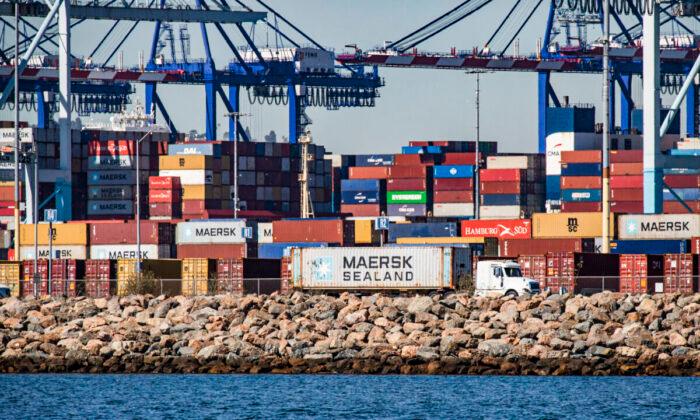The number of arriving cargo ships at the Port of Los Angeles likely won’t surge as the holiday season comes around, but the supply chain crisis is not yet over, according to experts and port officials.
The National Retail Federation, the world’s largest retail trade association, reported a slowdown in the cargo surge this month.
“Consumers are still buying, but the cargo surge we saw during the past two years appears to be slowing down,” said Jonathan Gold, the organization’s Vice President for Supply Chain and Customs Policy.
Though the volumes are above pre-pandemic levels, the rate of growth has been dropping compared with 2021’s “unusually high volumes,” according to Gold.
With inflation continuing and the Federal Reserve raising interest rates, imports at the nation’s major ports are expected to fall below last year’s levels for the remainder of the year, according to the federation.
Imports dropped 15 percent in August—about 806,000 containers—at the Port of Los Angeles compared to the same time last year, according to port officials.
The federation’s Global Port Tracker forecasts a 1.8 percent drop in September compared with the same time last year, 4.8 percent in October, 3.3 percent in November, and 4 percent in December.
The year-over-year decline is expected to continue into 2023, according to the federation.

Supply Chain Crisis Not Over
However, the slowdown doesn’t mean the supply chain crisis is over, according to San Mercogliano, a maritime historian and former merchant mariner.Instead, cargo ships have been choosing the East Coast and southern ports of entry, he said on his video blog “What is Going on With Shipping” on Sept. 6.
“Don’t think for a second just because there are no ships waiting off L.A. and Long Beach that the supply chain crisis—maritime side—is done,” he said. “You’ve just got to look at Houston, Savannah, New York, New Jersey, to see where the ships went.”
Cargo shippers began shipping earlier this year as they expected union contract negotiations between the International Longshore and Warehouse Union—which consists of more than 22,000 West Coast port workers—and about 70 employers represented by the Pacific Maritime Association, might affect operations at the Los Angeles and Long Beach ports. Talks have continued after the contracts expired July 1.
“That is why those volumes were so high in [the first half of] 2022,” Mercogliano said. “Everybody pushed their containers to the front end as much as they could in the first quarters of 2022.”
Canceled production orders in Asia are another factor slowing down shipping volume at the Port of Los Angeles, but 2022 is still the “second busiest year in [the port’s] history,” Executive Director Gene Seroka said Sept. 15.
“The bottom line, we’re projecting lighter numbers in September and for the balance of the year, compared to an unbelievable pace in 2021,” he said.

Diversions, Discussions, and Disputes
Locally, carriers are also choosing to deliver next door to the Port of Long Beach, according to Seroka.About 40,000 containers meant for Los Angeles were delivered to Long Beach in August, and Seroka expects another 60,000 to 80,000 more to do the same in September.
An ongoing discussion between the port and union leadership over health and safety measures around an automated area of one terminal is the reason for the switchover, which should be temporary, according to Seroka.
Additionally, holding times continue to climb for cargo waiting to be shipped by train, reaching an average of 7.5 days on the dock—almost four times longer than usual, according to port officials. About 16,000 out of 28,000 containers have been waiting longer than nine days.
The long wait time was caused by container backups in Chicago, Kansas City, and Dallas, according to Seroka.
Meanwhile, the port has made progress in moving goods. Containers waiting to be loaded onto trucks and delivered has dropped to 2,000 on the dock compared to a high of 32,000 last October.
On Sept. 15, just 11 cargo ships were waiting outside the port for a berth—compared with a record number of 109 ships in January.
At the same time, ship backups continue at the ports of Savannah, Houston, New York, and New Jersey as carriers divert vessels through the Panama Canal.
The Southern California port complex is still recovering from record container ship numbers at the beginning of this year while a looming rail labor strike was recently diverted, Seroka said.
Executive directors at the Los Angeles and Long Beach ports praised the railway union for reaching a tentative contract agreement and avoiding a nationwide railway strike.
“The Port of Long Beach welcomes the stability this contract agreement provides during a time when the prompt, reliable delivery of goods has become a consumer expectation,” Port of Long Beach Executive Director Mario Cordero said in a statement. “The San Pedro Bay port complex moves 40% of the nation’s cargo, and almost 30% of U.S. freight moves by rail. It’s not difficult to see what an interruption of service during the critical peak shipping season would have meant both here and for the greater national supply chain.”
Los Angeles port director Seroka also celebrated the news.
“This is great news for our nation’s supply chain and all Americans,” Seroka said. “Rail plays a vital role in the Port of Los Angeles. Two-thirds of goods arriving here leave California by rail. It’s a welcome development and we look forward to ratification.”





